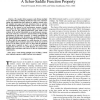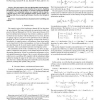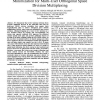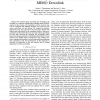97
Voted
TWC
2010
14 years 7 months ago
2010
We develop a realistic model for multiple-input multiple-output (MIMO) broadcast channels, where each randomly located user's average SNR depends on its distance from the tran...
107
click to vote
JSAC
2011
14 years 7 months ago
2011
— We investigate spectrum sensing by energy detection based on two different objective functions: a Bayesian sensing cost or the network weighted sum capacity. The Bayesian cost ...
121
click to vote
TIT
2002
14 years 12 months ago
2002
We consider direct sequence code division multiple access (DS-CDMA), modeling interference from users communicating with neighboring base stations by additive colored noise. We con...
93
Voted
TIT
2008
15 years 7 days ago
2008
Abstract--The sum capacity of the one-sided parallel Gaussian interference channel is shown to be a concave function of user powers. Exploiting the inherent structure of the proble...
116
click to vote
TCOM
2008
2008
Relay assisted F/TDMA ad hoc networks: node classification, power allocation and relaying strategies
15 years 7 days ago
This paper considers the design of relay assisted F/TDMA ad hoc networks with multiple relay nodes each of which assists the transmission of a predefined subset of source nodes to ...
107
click to vote
CORR
2008
Springer
15 years 13 days ago
2008
Springer
Abstract--In this paper, the sum capacity of the Gaussian Multiple Input Multiple Output (MIMO) Cognitive Radio Channel (MCC) is expressed as a convex problem with finite number of...
CORR
2008
Springer
15 years 13 days ago
2008
Springer
New upper bounds on the sum capacity of the two-user Gaussian interference channel are derived. Using these bounds, it is shown that treating interference as noise achieves the sum...
112
click to vote
GLOBECOM
2006
IEEE
15 years 6 months ago
2006
IEEE
—We demonstrate that receive antenna selection (RAS) provides significant increase in the achievable sum rates for multi-user MIMO wireless downlinks that employ block diagonaliz...
130
Voted
ICC
2008
IEEE
15 years 6 months ago
2008
IEEE
— Recently a number of transmission schemes have been introduced to achieve sum capacity for multiuser multiinput multi-output (MIMO) broadcast channels (BC). A block diagonaliza...
121
click to vote
CISS
2008
IEEE
15 years 6 months ago
2008
IEEE
—We consider linear precoding and decoding in the downlink of a multiuser multiple-input, multiple-output (MIMO) system. In this scenario, the transmitter and the receivers may e...




